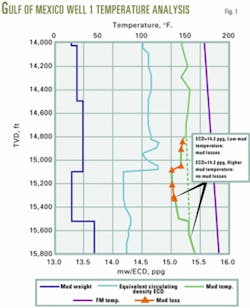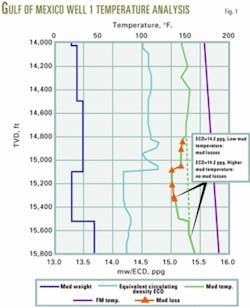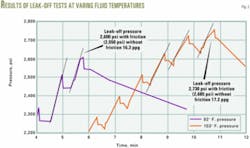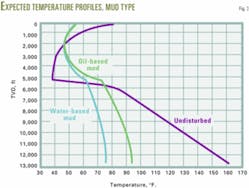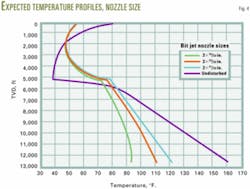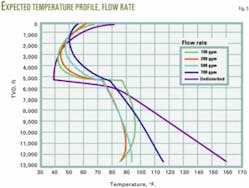Drilling operations cause changes in wellbore temperatures that can significantly impact effective fracture gradients.
For example, circulation on bottom usually produces bottomhole temperatures that are below the static geothermal temperature. The cooling reduces wellbore stresses and consequently produces lower effective fracture gradients that can result in costly lost-circulation events.
Some of these adverse thermal effects can be managed by adjusting parameters of the drilling process such as mud properties and hydraulics. Thermal simulation modeling can help identify these parameters and assist in developing optimum thermal management systems.
Lost-circulation events
A recent examination of historical lost-circulation events, particularly in deepwater environments, indicated a correlation between wellbore temperature and some lost-circulation events. Further investigation also revealed that changes in wellbore temperature often result from specific drilling operations.
Fig. 1 illustrates a lost-circulation incident that coincided with significant decreases in circulating mud temperatures. The example is from a deepwater well in a Gulf of Mexico field development program. Two other wells analyzed were subsalt wells drilled in water deeper than 4,000 ft. In both of these wells, circulation losses could be correlated to sudden large reductions in bottomhole mud temperatures that resulted from changes in operating parameters.
Downhole temperature and pressure data from another well indicated no circulation losses at 17,000 ft at an equivalent circulating density (ECD) of 14.8 kbm/gal when the bottomhole temperature was 145° F. When the bottomhole temperature decreased to 130° F., losses occurred even though the ECD had not changed.
In a 1995 case study,1 minor losses in the North Sea were followed by wellbore ballooning and eventually formation breakdown. The authors believed that cold mud reduced the near-wellbore fracture gradient, causing these problems. When mud circulation was stopped and the mud warmed to near-geothermal temperatures, increased near-wellbore compressive stresses caused the fractures to close. The resulting mud gain in the mud pits was misinterpreted as kicks caused by the influx of formation fluids.
Thermal effects on formation stress
Injecting large volumes of liquid, cooler than the in situ reservoir, can significantly reduce fracturing pressures in a formation.2 3 In fact, one model predicted that a mud temperature 108° F. lower than the formation temperature would result in a tensile stress of 1,015 psi around the wellbore.4 This equates to about 100-psi tensile stress reduction for every 10° F. reduction in temperature for the case modeled.
Thermoporoelastic models5-8 consistently predict that the thermal effects of mud temperature will be greatest soon after drilling and that thermally induced instabilities move away from the wellbore as time lapses.4 Models predict that mud cooler than the reservoir will inhibit shear failure of the formation early because of a reduction in pore pressure and reduction of compressive forces around the wellbore.4 However, the beneficial result of cooling dissipates with time, resulting in the potential for time-delayed formation collapse.4 6
Wellbore temperatures that are cooler than those of the formation reduce breakdown (fracturing) pressure.7 Changes in wellbore temperature have a greater effect on the formation breakdown pressure than on the formation collapse pressure.6 The effect on breakdown pressure is a function of the thermal expansion coefficient of the rock. Each 5.56.3.10-6/°F. change in volumetric thermal expansion coefficient changes the breakdown pressure by 0.15 kbm/gal.7
Thermal effects may also explain evidence of increased leak-off pressures over time in some wells. Warmer mud rising from deeper formations could increase the temperature at the casing shoe more than it would have been at the time of a leak-off test (LOT). Thermal effects have also been blamed for some wellbore collapses in which formations were heated by mud from deeper formations that ascended the annulus of the wellbore.4 6 9
Testing the drilling fluid
To determine whether the temperature of the drilling fluid directly affects the fracture gradient of the formation, technicians conducted a field test onshore in South Texas.
To address the concern that repeated LOTs would weaken the formation near the casing shoe and result in a final LOT value lower than the value from an unaltered formation, the LOTs were started at the lowest temperature because any measured increase in fracture gradient would represent a minimum value and increase confidence in the results.
The net result was a 0.9 kbm/gal equivalent mud-weight increase in the effective fracture gradient for a temperature increase of 61° F. (Fig. 2).
Factors influencing wellbore temperature
Wellbore temperatures are influenced by numerous factors, including ambient temperature, geothermal static temperature, wellbore configuration, drilling fluid properties, cement properties, circulating parameters, and the mud-circulating system.
As a thermodynamic system, energy added to the wellbore and circulating system produces some combination of work and heat. During drilling operations, the mud pumps add hydraulic energy to the system and the rotating system adds mechanical energy. Compared to the hp input from rotational energy sources, the hydraulic hp input is much greater. In fact, one study10 concluded that hydraulic energy usually accounts for 10 times more heat than does mechanical energy.
The specific heat capacity of drilling fluids can significantly affect wellbore temperatures as a result of heat produced or lost in the wellbore. For example, temperatures of oil-based fluids increase about two times more than water-based fluids with the same amount of heat.
Because a large part of hydraulic energy is used in the form of pressure drops across the bottomhole assembly and bit, the internal diameter of BHA components and total flow area across bit jet nozzles are significant factors affecting wellbore temperatures.
Heat transfer by convection and conduction also directly affects wellbore temperatures. Heat transfer by forced convection occurs with fluid circulation in the open hole between the fluid and the formation. Heat transfer by conduction occurs between the fluid inside the drillstring through the cross-section of the wellbore and the formation. Because flow rate impacts both hydraulic energy and heat transfer by forced convection, changes in flow rate provide significant changes in wellbore temperatures.
Thermal properties of wellbore components also affect wellbore temperatures because they determine the temperature change resulting from energy added to the system and the heat-transfer process. For example, various thermal insulation methods effectively lower thermal conductivity, especially for deepwater drilling risers.
Deepwater well simulation
To determine the relative influence of various factors on wellbore temperature, a thermal flow simulator was used to model a deepwater well. The simulator was a refinement of that described by Mitchell and Wedelich.11 The well was a subsea vertical well with a total depth of 15,000 ft. The objective was to predict circulating temperatures while drilling from 10,000 to 12,500 ft.
Predicted temperature profiles were shown at the end of each modeled operation. To determine the level of sensitivity, technicians adjusted operating parameters across a range and noted changes to circulating temperatures.
Results from the simulation indicate that several controllable factors can influence wellbore temperatures during drilling. For example, the type of mud and its properties affected wellbore temperatures in a number of ways. When downhole processes generate heat, the fluid temperature increase is directly affected by the fluid heat capacity.
In the drilling and circulating process, heat is transferred between the drillstring fluid, the drillstring, the annulus fluid, and the formation. This heat transfer is affected by the thermal and rheological properties of the mud. Fig. 3 illustrates the difference between the expected temperature profiles for a water-based mud and an oil-based mud.
Mud weight also affected temperature profiles through hydraulic effects as well as thermal properties. Much of the temperature difference was attributed to the greater flowing friction (and therefore standpipe pressure) associated with the higher mud weight. Using a 16-ppg mud rather than a 10-ppg mud added 540 hp to the system. This extra horsepower ultimately produced higher downhole temperatures. In addition, the specific heat capacity of the drilling fluid was also lowered, contributing to higher temperatures as well.
One process that generated heat downhole was the pressure drop through the drillstem components and bit nozzles. If standpipe pressure or flow rate is not already maximized, higher downhole temperatures can be obtained by increasing the hydraulic hp expended downhole.
Smaller internal diameter BHA components, smaller bit nozzle total-flow areas, and higher flow rates can all contribute to higher hydraulic hp. Fig. 4 illustrates the differences in expected temperature profiles for various nozzle selections. For example, decreasing the nozzle diameter to 11/32 in. from 16/32 in. increases the temperature at TD by 28° F.
Fig. 5 illustrates the changes in temperature with flow rate changes. As flow rate is decreased, the resulting decrease in energy input to the wellbore causes the temperature profile initially to become cooler. However, a point is reached where further flow-rate reductions produce less heat loss to the cooler overburden and therefore lead to warmer overall wellbore temperatures.
Mud temperature can be actively increased in a number of ways, including addition of heat to the mud on surface and expenditure of hydraulic hp downhole. The location of a mud temperature increase affects the temperature profile. A similar temperature can be achieved at TD by either using smaller nozzles or by adding heat to the mud at surface. However, adding heat at surface produces a much greater energy loss in cooler portions of the well because of a greater temperature difference between the mud and its surroundings.
For one case modeled, the higher standpipe pressure required for the smaller nozzles would produce an additional 664 hp through the mud pumps. This hydraulic horsepower is converted to heat at TD and increases the BHT. To achieve a similar BHT increase by heating the mud at surface, 6.1 million btu/hr (equivalent to 2,400 hp) would be required. However, the two effects are additive.
As flow rate influences circulating temperatures, time exposure to the open hole also influences the temperature profile. Simulated drilling of the hole section showed an initial decrease in the BHT until a steady-state point was reached, then the BHT increased with time. The changes in BHT were smaller than those predicted for other sensitivities studied, but the effect was noticeable.
Insulation of the deepwater drilling riser was modeled with thermal conductivity values varying from 1 to 10 btu/hr-ft-°F. and varying in thickness up to 6 in. The maximum BHT increase was approximately 3° F. This would indicate that very low thermal conductivity insulation material would be needed to have a significant impact on BHT.
In deepwater scenarios, boosting the riser annulus to assist in annular velocities for hole cleaning is a common practice. This process can impact the BHT. The effect is based on the inlet temperature of the boost flow as it joins the riser annulus flow, the rate at which it flows into the riser annulus, and the temperature of the riser annulus flow (when not being boosted). If the boost flow is cooler than the non-boost flow, the overall flow is cooled (the converse effect also applies). The rate of the boost line flow enhances the cooling or heating effect.
When drilling a hole section, the temperatures at the previous casing shoe tends initially to decrease as heat rises to the cooler portion of the hole and is released. Eventually, however, the shoe temperature will begin to rise, as more heat is available from deeper in the well.
Managing wellbore temperatures
Wellbore temperatures clearly depend on a number of factors, some of which can be controlled in drilling operations. How drilling operations ultimately influence fracture gradient depends on energy inputs into the wellbore, heat transfer within the wellbore, and heat transfer between the circulating system, wellbore, and surroundings (atmosphere, ocean, and formation). The heat transfer from the interaction of the various items is complex but must be understood to manage temperatures to improve drilling performance.
The simulations indicate that controlling certain factors during a drilling operation can significantly impact downhole temperature profiles. Minimizing the cooling effect from bottomhole circulation can increase effective fracture gradients and the corresponding pore pressure/fracture gradient margin, avoiding costly lost circulation and additional unnecessary casing points. Mud properties, energy additions, and energy conversion processes produced the greatest impacts on downhole temperatures. Other factors such as riser insulation and riser boost had less impact.
Future considerations
As thermal management systems are adopted and used in the industry to minimize lost-circulation risks and increase effective fracture gradients, especially in deepwater environments, several advancements in technology and operating practices may be realized. Among them are higher-pressure circulating systems, surface-heating systems, and thermal insulation for circulating systems and deepwater drilling risers. The strong impact of the seawater column could potentially give rise to the development of dual risers or composite riser materials.
Combining thermal-simulation models with wellbore-stability and pressure-prediction models may also enable real-time determination of the dynamic pressure profile that exists in wellbores as a result of changing wellbore temperatures.
References
1. Maury, V,. and Idelovici, J.L., "Safe Drilling of HP/HT Wells: The Role of the Thermal Regime in Loss and Gain Phenomenon," SPE/IADC Drilling Conference, Amsterdam, Feb. 28-Mar. 2, 1995.
2. Perkins, T.K., and Gonzalez, J.A., "Changes in Earth Stresses Around a Wellbore Caused by Radially Symmetrical Pressure and Temperature Gradients," SPE Fall Technical Conference, Dallas, Oct. 5-7, 1981.
3. Perkins, T.K., and Gonzalez, J.A., "The Effect of Thermoelastic Stresses on Injection Well Fracturing," SPE Journal, February 1985, pp. 78-88.
4. Tang, L., and Luo, P., "The Effect of Thermal Stress on Wellbore Stability," SPE India Oil and Gas Conference, New Delhi, Apr. 7-9, 1998.
5. Li, X., Cui, L., and Roegiers, J.-C., "Thermoporoelastic Analyses of Inclined Boreholes," SPE/ISRM Eurock '98 Conference, Trondheim, July 8-10, 1998.
6. Choi, S.K., and Tan, C.P., "Modeling of Effects of Drilling Fluid Temperature on Wellbore Stability," SPE/ISRM Eurock '98 Conference, Trondheim, July 8-10, 1998.
7. Yu, M., Chen, G., and Chenevert, M.E., "Chemical and Thermal Effects on Wellbore Stability of Shale Formations," SPE Annual Technical Conference, New Orleans, Sept. 30-Oct. 3, 2001.
8. Chen, G., and Ewy, R.T., "Thermoporoelastic Effect on Shale Stability," Soil and Rock America 12th Panamerican Conference on Soil Mechanics and Geotechnical Engineering, Cambridge, Mass., June 22-25, 2003.
9. Maury, V.M., and Sauzay, J.-M., "Borehole Instability: Case Histories, Rock Mechanics Approach, and Results," SPE/IADC Drilling Conference, New Orleans, Mar. 15-18, 1987.
10. Maury, V,. and Guenot, A., "Practical Advantages of Mud Cooling Systems for Drilling," SPE/IADC Drilling Conference, Amsterdam, Feb. 23-25, 1993.
11. Mitchell, R.F,. and Wedelich III, H.F., "Prediction of Downhole Temperatures Can Be Key for Optimal Wellbore Design," SPE Production Operations Symposium, Oklahoma City, Mar. 13-14, 1989. F
The authors
Manuel Eduardo Gonzalez ([email protected]), senior engineering advisor, has more than 23 years of experience with HTHP and deepwater wells with Exxon, Texaco, and now ChevronTexaco. He has more than 15 patents, many licensed to major Service Companies, many professional papers published in several oil industry publications. Previously, Gonzalez was co-owner of a wireline company and a successful high tech company from technologies spun out of Los Alamos National Laboratories. He is a member of SPE.
J. Benjamin Bloys ([email protected]) is a staff research scientist for ChevronTexaco. His primary areas of responsibility are drilling fluids, low invasion coring, hydrates, and drilling waste management. Bloys worked 17 years at the ARCO Technology Center before joining ChevronTexaco Energy Technology Co. in 2000. He holds a BS degree in chemistry from Angelo State University (1984). Bloys has 15 technical publications, 11 patents and is a member of SPE, AADE, ACS and API.
Joseph H. Schmidt ([email protected]) has 25 years of experience working on mechanics related problems in the oil and gas industry, including 20 years at ARCO. Schmidt spent more than 35% of his industrial career in operating districts, principally Prudhoe Bay, and is a listed inventor on 16 US patents and 1 Canadian patent. He has a BS in marine engineering (1966), as well as a BS (1970), MEng (1972), and PhD (1978) in mechanical engineering from Texas A&M University and he is a member of SPE.
Carey J. Naquin ([email protected]) is a senior managing consultant in the asset performance consulting group of Landmark Graphics Corp., a division of Halliburton Energy Services. With a focus on drilling and completion engineering and operations management, Naquin has 25 years of experience in the Gulf of Mexico shelf and deepwater, Rocky Mountains, Permian basin, North Sea, Middle East, and Indonesia. Most recently, he has focused on thermal simulation and thermal stress management in wellbores. Prior to joining Halliburton in 1995, he served as a district engineer with Placid Oil Co. Naquin earned a BS in petroleum engineering from Lousiana State University in 1979 and he is a member of SPE.
